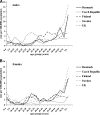Epidemiology of severe Streptococcus pyogenes disease in Europe
- PMID: 18463210
- PMCID: PMC2446932
- DOI: 10.1128/JCM.00422-08
Epidemiology of severe Streptococcus pyogenes disease in Europe
Abstract
The past 2 decades have brought worrying increases in severe Streptococcus pyogenes diseases globally. To investigate and compare the epidemiological patterns of these diseases within Europe, data were collected through a European Union FP-5-funded program (Strep-EURO). Prospective population-based surveillance of severe S. pyogenes infection diagnosed during 2003 and 2004 was undertaken in 11 countries across Europe (Cyprus, the Czech Republic, Denmark, Finland, France, Germany, Greece, Italy, Romania, Sweden, and the United Kingdom) using a standardized case definition. A total of 5,522 cases were identified across the 11 countries during this period. Rates of reported infection varied, reaching 3/100,000 population in the northern European countries. Seasonal patterns of infection showed remarkable congruence between countries. The risk of infection was highest among the elderly, and rates were higher in males than in females in most countries. Skin lesions/wounds were the most common predisposing factor, reported in 25% of cases; 21% had no predisposing factors reported. Skin and soft tissue were the most common foci of infection, with 32% of patients having cellulitis and 8% necrotizing fasciitis. The overall 7-day case fatality rate was 19%; it was 44% among patients who developed streptococcal toxic shock syndrome. The findings from Strep-EURO confirm a high incidence of severe S. pyogenes disease in Europe. Furthermore, these results have identified targets for public health intervention, as well as raising awareness of severe S. pyogenes disease across Europe.
Figures




References
-
- Auerbach, S. B., B. Schwartz, D. Williams, M. G. Fiorilli, A. A. Adimora, R. F. Breiman, and W. R. Jarvis. 1992. Outbreak of invasive group A streptococcal infections in a nursing home. Lessons on prevention and control. Arch. Intern. Med. 1521017-1022. - PubMed
-
- Ben Abraham, R., N. Keller, R. Vered, R. Harel, Z. Barzilay, and G. Paret. 2002. Invasive group A streptococcal infections in a large tertiary center: epidemiology, characteristics and outcome. Infection 3081-85. - PubMed
-
- Cone, L. A., D. R. Woodard, P. M. Schlievert, and G. S. Tomory. 1987. Clinical and bacteriologic observations of a toxic shock-like syndrome due to Streptococcus pyogenes. N. Engl. J. Med. 317146-149. - PubMed
Publication types
MeSH terms
LinkOut - more resources
Full Text Sources
Other Literature Sources
Medical
Miscellaneous

